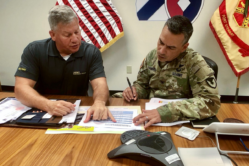With the current military drawdown, involuntary separations will be a way of life for military members for the foreseeable future. Unfortunately, being informed you will be involuntarily separated from the military usually comes with little notice. You will likely go through a range of emotions as you come to terms with the fact that your military career is ending, whether you want it to or not.
We covered this topic recently in a podcast about Force Shaping and involuntary separations. The podcast covers some of your options, including the benefits that will be made available to you, the option of joining the Guard or Reserves, early retirement, or in some situations, being eligible to receive separation pay.
This article covers separation pay in more detail, including an overview of the eligibility requirements, types of separation pay, how to calculate involuntary separation pay, and more.
Table of Contents
- Military Separation Pay Eligibility (Non-Disability)
- How to Calculate Involuntary Separation Pay
- Important Things to Know About Separation Pay
- Taxes:
- Separation Pay & Joining the Guard or Reserves:
- Separation Pay and VA Service-Connected Disability Compensation:
- Additional Separation Pay Notes:
- Military Drawdown – How to Prepare for Involuntary Separation
- Prepare for a Troop Reduction – Just in Case
- Get up-to-date information
- Communicate
- Examine your options inside and outside of the service
- Consider the Guard or Reserves
- Brush up on your skills
- Understand How an Involuntary or Voluntary Separation Will Impact You
- Prepare for Unemployment – Just in Case
Military Separation Pay Eligibility (Non-Disability)
Military separation pay is comparable to the severance pay you might find in the civilian world. However, not all servicemembers involuntarily separated from the military are eligible to receive separation pay benefits. There are also two types of pay, (1) Full Separation Pay, and (2) Half Separation Pay. (for the purpose of this article, we are not considering separation pay for a disability).

Full Pay Eligibility:
You must have served at least 6 years on active duty, but less than 20 years* to be eligible for involuntary separation pay. In addition to the service time requirements, you need to be fully qualified for retention when you are let go, and your service must be characterized as “Honorable.”
Common reasons for being eligible to receive involuntary separation pay include separated under Force Shaping, or Reduction in Force measures, or exceeding high-year tenure for your rank.
To qualify for Full Separation Pay, the service member must agree to serve in the Ready Reserve or similar Reserve Component for a minimum of 3 years following release from active duty service.
Half Pay Eligibility:
Half Pay also requires a minimum of 6 years of active service and less than 20. However, servicemembers can get by with an “Honorable” or “General” discharge. Some common examples include involuntary separation due to failure to meet fitness/weight standards, loss of security clearance, involuntary discharge due to parenthood, etc. Check with your personnel department to verify you will be eligible for separation pay.
*Service of more than 15 years, but less than 20:
In some cases, those who have served at least 15 years on active duty may be eligible to retire under TERA rules. However, TERA is only offered on a case-by-case basis and is not guaranteed to everyone with 15 years of service. You need to apply for TERA, and it needs to be approved by your branch of service. Hopefully, those who have served at least 15 years will be eligible to retire under TERA, as the retirement benefit is substantially more valuable than the one-time, lump-sum payment that comes from involuntary separation pay.
How to Calculate Involuntary Separation Pay
Here is how to calculate full military separation pay:
- 10% x Years of Active Duty Service x 12 x Most Recent Monthly Base Pay.
- Months of service are counted as 1/12 of a year.
You can express this in words such as, “10% of your annual base pay multiplied by the number of years you served.”
Let’s work through an example of an E-5 receiving involuntary separation pay at 6 years:
$2,734.50 base pay x 12 = $32,814.00
$32,814.00 x 6 (number of years served) = $196,884.00
$196,884.00 x 10% = $19,688.40 = Full Separation Pay.
To determine the separation pay you may be eligible to receive, simply plug in your base pay and the number of years (including fractions) and multiply by 10%. The longer you have served and the higher your rank, the greater the value of your separation payment.
Important Things to Know About Separation Pay
Taxes:
Taxes will be withheld from your separation pay, usually at a rate of 20% or 25%. So far as I know, you cannot change the withholding rate. If you overpay your taxes, you will receive a refund when you file your tax return the following year. Taxes will be handled similarly to taxes on a military bonus.
Separation Pay & Joining the Guard or Reserves:
You may be eligible to join the Guard or Reserves after leaving active duty military service, even if you receive separation pay. However, if you go on to retire from the Guard or Reserves, you will be required to pay back your separation pay. DFAS will withhold 40% of your retirement pay until you have paid back the separation pay you received. There is no option for repaying the balance in a lump sum, but you can request that DFAS increase your withholding to speed up your repayment of the separation pay. Here is more information about paying back separation pay upon retirement.
Don’t let the possibility of repaying the separation pay prevent you from joining the Guard or Reserves. This can be a great way to continue your military career and earn important benefits for yourself and your family.
Separation Pay and VA Service-Connected Disability Compensation:
Federal law requires the VA to withhold compensation pay for veterans separation pay, severance pay, and readjustment pay, less any federal taxes already paid. This applies to both voluntary and involuntary separation pay. Here is more information about when the VA can recoup disability compensation.
Additional Separation Pay Notes:
Separation pay benefits can be complicated, and each situation is unique. The DoD Reg for separation pay is over 60 pages long (DoDFMR 7000.14R, Chapter 35, Section 3502, Separation Pay (Nondisability) – pdf) and includes many exclusions and other information. The goal is to give you a rough idea of how the benefit works so you can run some calculations on your own. It’s up to you to ensure you double-check your status with your finance or personnel office to verify your situation.
You can also read the law as written in 10 U.S. Code § 1174 – Separation pay upon involuntary discharge or release from active duty.
Military Drawdown – How to Prepare for Involuntary Separation
The military has undergone several periods of force reductions through the years as they adapt to the new realities of budget constraints, the drawdown of troops stationed overseas, and the changing face of present-day warfare. None of the branches escaped the cuts, though some were hit harder than others.
For example, several years ago, the Army lost 50,000 active duty troops over 5 years. Most troops were scheduled to leave the service through retirement and normal attrition, but thousands were subjected to voluntary and involuntary separations.
Troop reductions aren’t a big event if you were already planning on retiring or separating from the service. But they can be a major curve ball if you were planning on making the military a career or weren’t sure what your long-term plans were.
This news can be stressful and make you ask a few important questions: Are you prepared to leave the service? What if you are involuntarily separated?
Unfortunately, there are no guarantees, and the military can cut your seemingly “safe” job at a moment’s notice. You should also be aware that once these plans go into place, they can happen quickly. The last thing you want to happen is to receive a force reduction notice when planning to make the military your career.
Prepare for a Troop Reduction – Just in Case
Here are some things you and your family can do to prepare for the Army troop reductions:
Get up-to-date information
Don’t fall asleep at the wheel – you need to do everything in your power to educate yourself about the impending troop cuts. Will they be in your career field? What about your rank? If you are in an overstaffed career field, consider cross-training or applying for special duty assignments to make you more attractive if your profile appears in front of a force reduction board.
Communicate
Communication is the most important aspect of personal finances, especially when you share financial responsibilities with a spouse. Keep your spouse up to date with what is going on with your career, the force reduction efforts, and how it might impact your position with the military. These may be tough conversations, but they are much easier to have in the advanced stages of the force reduction process than they are after you have been selected for involuntary separation.
Examine your options inside and outside of the service
The USAF went through a force reduction process while I was in the service. It didn’t affect my career field or pay grade, but I knew quite a few Airmen who were allowed to cross-train or separate from the service. You will need to look at your civilian career opportunities and compare them to available ones. Take some time to consider your skills, civilian job prospects, and the state of the economy before leaping.
Consider the Guard or Reserves
You might also consider switching over to the National Guard or Reserves. You may also be able to transfer into the Guard/Reserves from a sister service. Most Guard and Reserve branches will welcome members from sister services with a minimum of additional training (usually just the tech school for the job to which you are applying).
Brush up on your skills
Now is the best time to start padding your resume. Make sure your training is up to date, and take advantage of any military or educational opportunities that come your way. You may also consider working online or night classes into your schedule or working toward professional certifications, which you can use on the outside. Tuition Assistance may help pay for some or all of these courses.
Helpful Resources:
- Force Shaping and Involuntary Separations – How to Handle Being Laid Off from the Military (article and podcast)
- Planning Your Military Exit – Even if You Don’t Know When it Will Be – (article and podcast)
- Military to Civilian Transition Tips (article and podcast)
Understand How an Involuntary or Voluntary Separation Will Impact You
The military uses several tools for reducing their numbers, including voluntary and involuntary separations and sometimes early retirement offers through a program called the Temporary Early Retirement Authority (TERA).
There are pros and cons to early retirement through TERA. The benefit is you are a full-retiree, with your military retirement pay, health care benefits, and all other benefits associated with being a retired military member. The downside is retiring early results in a reduced pension multiplier, resulting in a lower paycheck than you otherwise would have earned at full retirement. That said, it’s much better than getting shown the door with only an involuntary separation payment.
Voluntary and involuntary separations may earn the member a one-time cash payment based on rank and service years. You can learn more in our involuntary separation pay guide.
One item of note: voluntary and involuntary separation pay is intended to be a one-time cash bonus since the member was not eligible to remain in the military long enough to earn military retirement pay. You will have to repay the separation pay if you later rejoin the military and remain in the service long enough to reach retirement (active duty, or in the Guard / Reserves). You will also have to repay the separation pay if you are awarded a VA disability rating and subsequent compensation. (Sorry, both of these are baked into the law).
Prepare for Unemployment – Just in Case
I was unemployed for 6 months after I separated from the USAF. It was difficult, but I had one advantage over many people in the unemployment line: I was prepared for it, at least financially. Transitioning from the military was an emotional challenge, and is something many people don’t talk about.
Knowing that you are going to lose your job gives you an advantage and gives you time to prepare. Before you leave the service, contact the state employment bureau where you plan on living after you separate from the military. In most cases, non-retired military members are eligible for unemployment benefits. There are some exceptions, so be prepared for this – you should know your eligibility and how to file for unemployment benefits before you leave the service. You don’t want to wait as it could delay your benefits.
Consider the financial impact
Separating from the military is a big deal – you have a steady paycheck with perhaps the best benefit system in the US. Don’t underestimate the impact of losing your health insurance and other benefits. The next most important area to focus on is reducing your fixed expenses. This could be from getting out of debt, cutting expenses like cable or other subscriptions, refinancing a mortgage or other loan, or selling a car or other item with remaining payments. Reducing your fixed expenses gives you more financial flexibility when you no longer have a job.
Consider the emotional impact
One of the most difficult experiences I faced when I separated from the USAF was going from a role of responsibility to the unemployment line. It’s tough going from a respected shift leader who makes important decisions daily, to someone who is standing in line behind dozens of other people who are looking for work. It took me 6 months to find a job, which was a difficult period.
Know your benefits
Before separating, ensure you know which benefits you are eligible for. This could include things such as the GI Bill and VA Loan, or it could include things such as a pension, TRICARE, disability benefits, and more. Take good notes in your Transition Assistance Program (TAP) and set up a meeting with the VA if you have medical issues that need to be addressed. Getting as much done as possible is always better before leaving active duty military service.




Comments:
About the comments on this site:
These responses are not provided or commissioned by the bank advertiser. Responses have not been reviewed, approved or otherwise endorsed by the bank advertiser. It is not the bank advertiser’s responsibility to ensure all posts and/or questions are answered.
Mateo Ramirez says
Is anybody able to answer if you are able to file an ISP claim retroactively? Is there a statute of limitation when you are no longer able to file a claim? TIA for any assistance you’re able to provide.
Ryan Guina says
Mateo, I recommend contacting your parent branch of service’s human resources or personnel center (Army HRC, AFPC, BUPERS, etc.). Best wishes!
Peter D. says
Hello Ryan,
I just separated from the active-duty Air Force on 13 December and am due to receive 50% of my Involuntary Sep Pay. I also sold 55 days of my accrued Leave and after I crunched all of the numbers, subtracted taxes, from both pays, I should be due to receive around $30-33K. Yesterday, good ol’ DFAS paid me a deposit of a bit over $10K and I have NO idea what this amount came from. It sure as hell better not be my entire pay! I have already contacted my base’ finance office and they submitted a case to DFAS and I’m worried this could take forever. I am hoping more is on the way to me, they told me I would receive everything in one LUMP SUM payment but however, I still got a Mid-Month pay this week, separate from my $10K payment. I was HONORABLY DISCHARGED and should receive 50% ISP + my 55 days of Leave sold, can you help me?
Frank R. Douglas says
Hello, I wrote you before about the Exchange and Commissary Act which is finally done but not applied equally. Now I have a problem specifically for me. I finally reached 90 percent VA Comp and the VA decided to withhold 100 percent of that to repay Separation Pay from 1987. How are the two related? I did not receive VA comp at all until 2007 so if I owe repayment of Separation Pay from 1987 should the VA pay me Comp from 1987? The did this just as the Covid-19 Pandemic began. I am done to my social security of $800 a month. I did not get the $1200 as so many seem to have gotten. What can I do to reverse this VA action?
Elena says
I need some advice. I recently involuntarily separated due to parenthood with almost 7 years of active duty service. I have nothing bad on my record, and Honorable Discharge. I meet all of the requirements for half separation pay. My unit very abruptly forced me out with no advice on how to get separation pay and I had to do everything in a rush and on my own. I went through all of the necessary outprocessing briefings and I was not given my separation pay before exiting the military. I did not understand the whole process, but finance was not very helpful either. I was under the impression that they would send the money to my account along with my last month’s pay or sometime later on. Does anyone know where to take this issue? I have tried calling the finance office, but they did not care to help me.
Ryan Guina says
Elena, try contacting your branch of service’s headquarters level personnel office (AFPC, BUPERS, Army Human Resources Command, etc.). They should be the best point of contact for something like this. Best wishes.